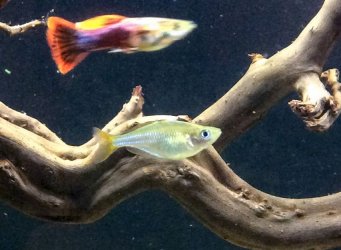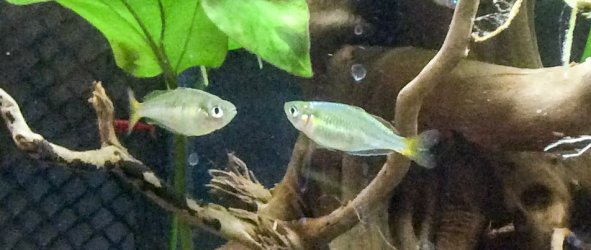The female Melanotaenia praecox rainbowfish looks like a young normal female with eggs. The 2 fish in the second pic look a bit skinny. Praecox are a very deep body fish (they get tall bodies) and when mature the males almost look like a round Australian 20cent coin. The females also develop tall bodies but not as much as males.
Rainbowfish are serial egg layers. They scatter a few eggs (5-20) into plants each day for an extended period of time. The male and female swim into some plants and release eggs & sperm at the same time. The eggs sink and have little hooks that attach to plants. The eggs hatch after about 1 week and the fry swim up to the surface and live just under the surface for a few weeks before moving into the middle of the tank.
Any fry that do pop up in the tank will be eaten by most of your fish. If you want to breed them set up a 2 foot long aquarium and put a thin layer of gravel in it with some Java Moss and some floating plants like Water Sprite (Ceratopteris thalictroides). Have a corner sponge filter and heater in the tank and a coverglass for it, (rainbowfish jump).
Feed the male and female fish 3-4 times per day with frozen and live food for several weeks before breeding. Then move the females into the breeding tank and continue feeding well for 4 days. After 4 days add the males and the following day do a 50% water change. Keep feeding the adult fish well for a week then remove the adult fish and put them back in their main tank.
A day or two after you remove the adults, there will be fry in the breeding tank. Feed the fry on green water, infusoria and liquid and powder fry foods for egg layers. When the fry are 2 weeks old you can start feeding newly hatched brineshrimp. Continue feeding the fry foods until all the fry are eating the baby brineshrimp. They will have little orange bellies

Then start doing daily water changes and feed heavily and in a few months you will have a tank full of blue fish

You can breed rainbowfish in pairs (1 male & 1 female) or groups containing more females than males. Groups are best and give young with more genetic variation.



